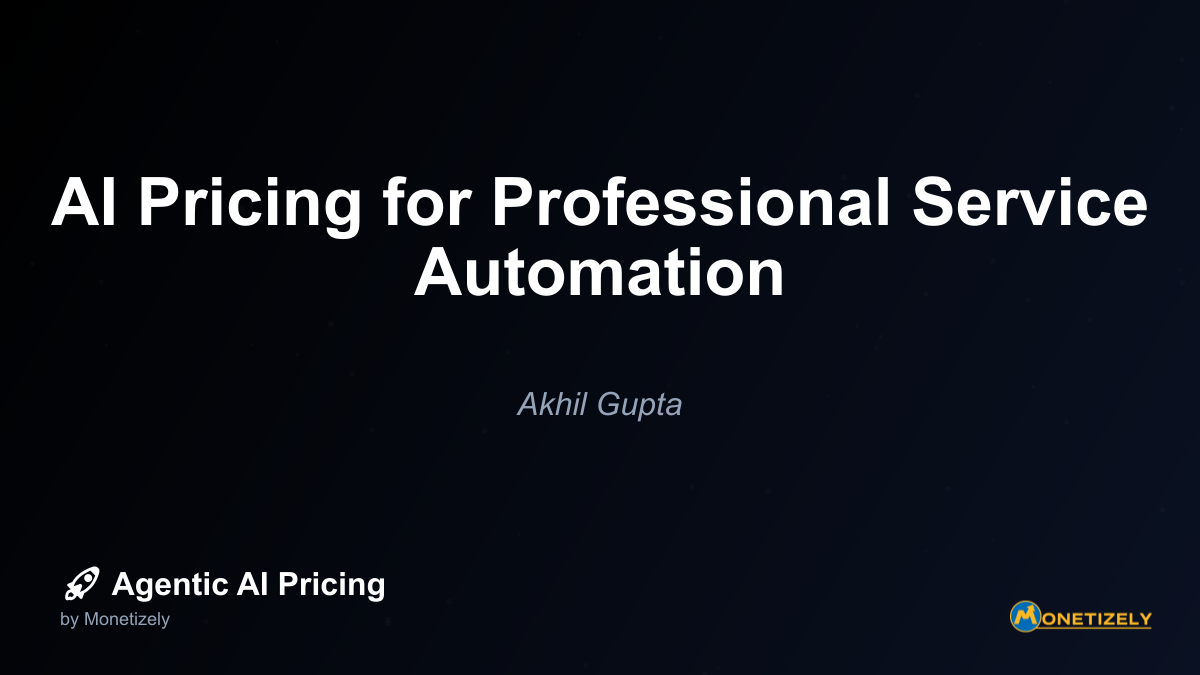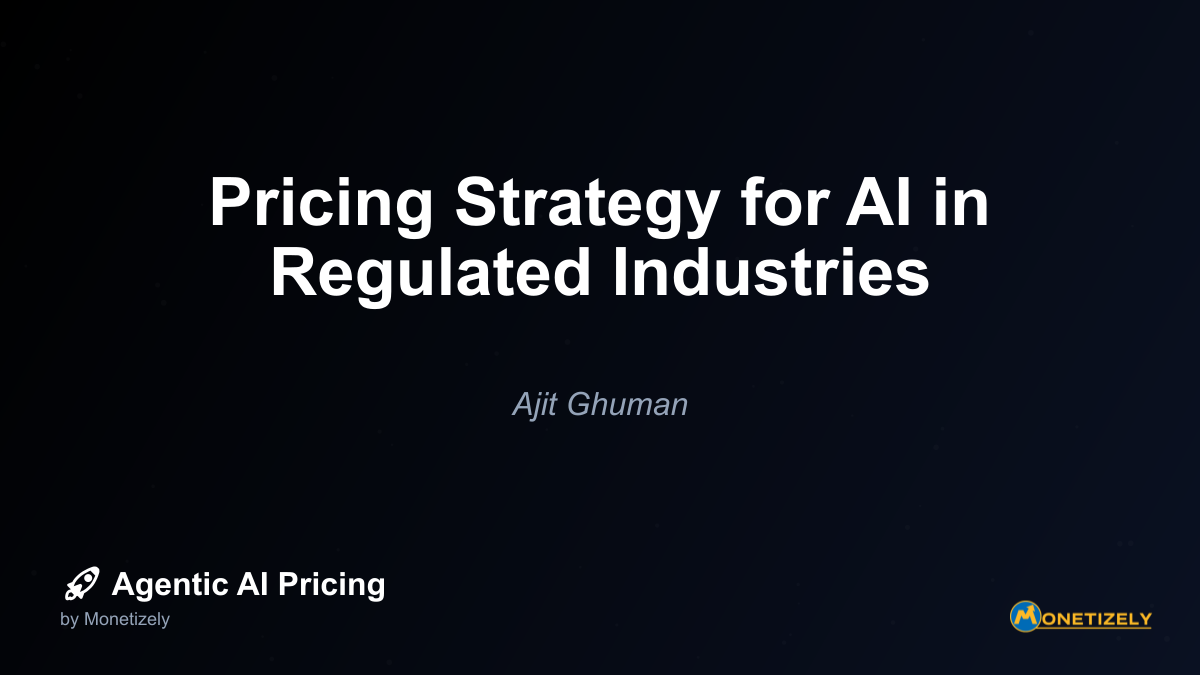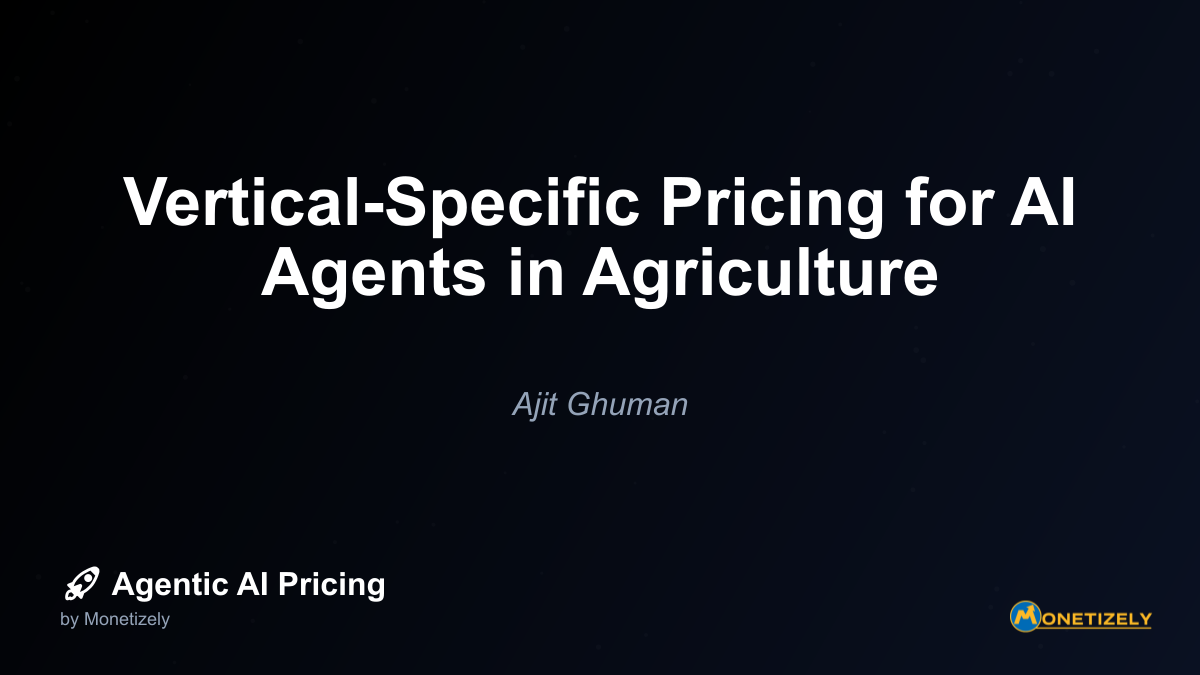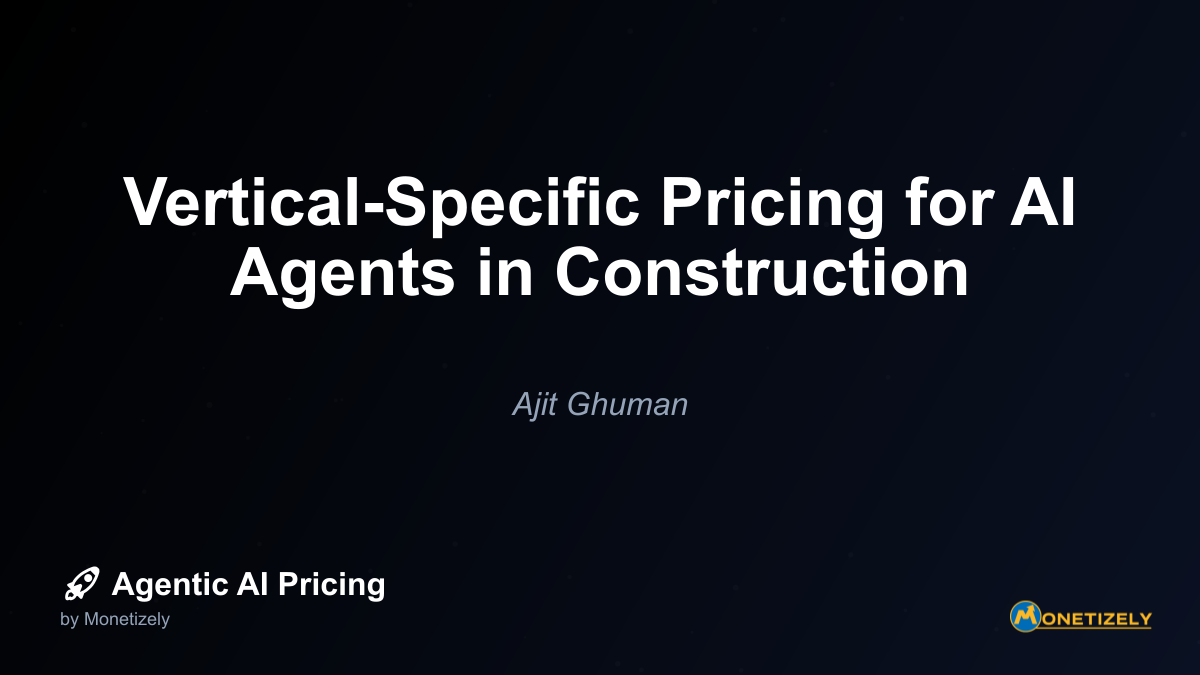· Akhil Gupta · Industry-Specific · 12 min read
Vertical-Specific Pricing for AI Agents in Healthcare
AI and SaaS Pricing Masterclass
Learn the art of strategic pricing directly from industry experts. Our comprehensive course provides frameworks and methodologies for optimizing your pricing strategy in the evolving AI landscape. Earn a professional certification that can be imported directly to your LinkedIn profile.
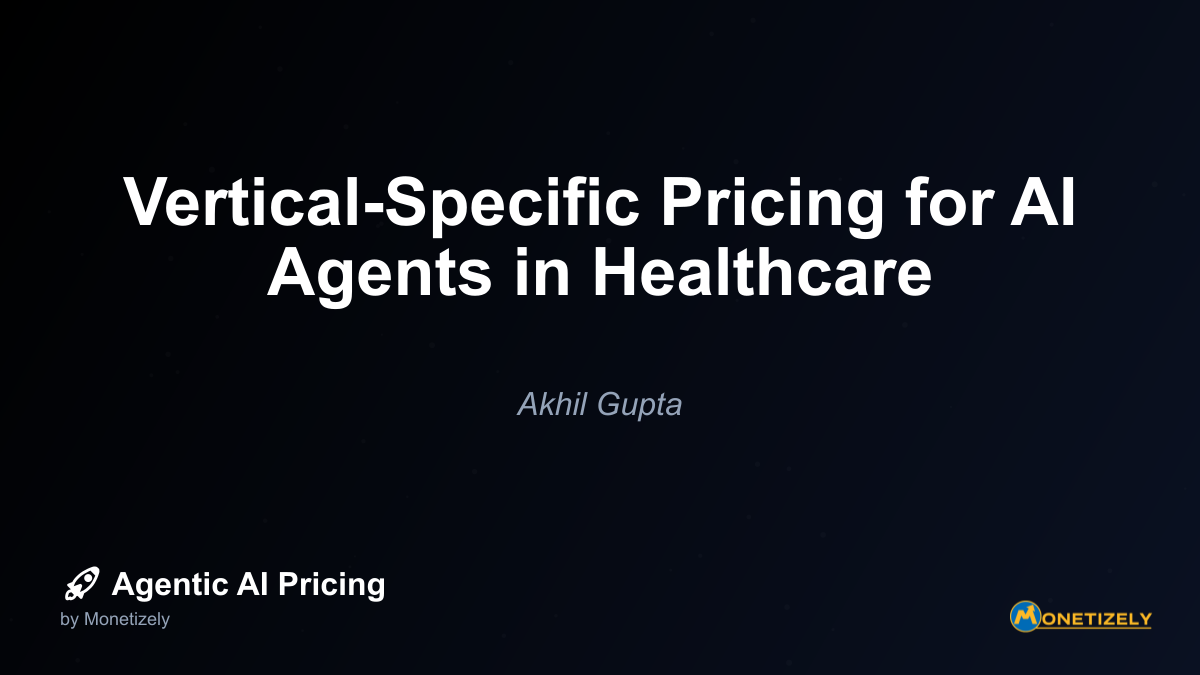
In healthcare, AI agents are revolutionizing everything from diagnostics to patient engagement. Yet pricing these tools presents unique challenges not found in other sectors. Healthcare’s complex regulatory landscape, diverse stakeholders, and ethical considerations create a pricing environment that demands specialized approaches tailored to the industry’s unique needs.
This article examines the intricate considerations that shape effective pricing strategies for AI agents in healthcare. We’ll explore the regulatory frameworks that influence pricing decisions, analyze the value metrics that resonate with different stakeholders, and provide actionable frameworks for developing pricing strategies that align with both business objectives and healthcare’s mission-driven nature.
Understanding the Healthcare AI Pricing Landscape
Healthcare AI pricing exists within a multifaceted ecosystem where traditional software pricing models often fall short. The stakes are higher, the regulations more stringent, and the value metrics more complex than in most other industries.
Current Market Trends in Healthcare AI Pricing
The healthcare AI pricing landscape is rapidly evolving, with several key trends emerging:
Shift from traditional to value-based models: Healthcare AI pricing is moving away from seat-based or simple subscription models toward sophisticated outcome-driven approaches that align vendor compensation with clinical or operational improvements.
Implementation cost structures: Healthcare AI implementation typically includes multiple cost components:
- Proof of concept: $15,000–$50,000
- Custom AI models: $50,000–$500,000+
- Data annotation: $10,000–$200,000
- Integration: $7,800–$35,000
- Infrastructure: $5,000–$100,000 (one-time) or $430–$15,000/month (ongoing)
- Regulatory compliance/training: $10,000–$150,000 annually
- Scaling: $50,000–$500,000+
Model development approaches: Organizations face three primary options:
- Building in-house models: $250,000–$500,000 for deep learning on specialized tasks
- Licensing commercial LLMs: $100,000–$500,000 annually depending on volume
- Fine-tuning open-source models: $50,000–$200,000
Investment acceleration: Healthcare AI startups are receiving substantial funding, with AI-enabled startups capturing 62% of digital health venture capital in the first half of 2025 ($3.95 billion) and demonstrating higher average deal sizes than other digital health segments.
The Market Opportunity
The growth potential for healthcare AI is substantial. Industry projections suggest AI could reduce US healthcare costs by approximately $13 billion by 2025 through automation and improved diagnostics. The global traditional, complementary, and integrative medicine market approaches $600 billion, with AI expected to accelerate growth and innovation in healthcare delivery.
Studies indicate AI-enabled patient platforms can reduce hospital readmission rates by 30% and cut clinician patient-review time by up to 40%, contributing to ROI through operational efficiencies and better outcomes. These metrics provide compelling evidence for the value proposition of healthcare AI solutions.
Regulatory Compliance: The Foundation of Healthcare AI Pricing
Unlike many other industries, healthcare AI pricing must account for extensive regulatory requirements that impact development costs, operational expenses, and liability considerations.
Key Regulatory Frameworks Affecting Healthcare AI Pricing
Several regulatory frameworks directly influence pricing strategies:
FDA Regulation: The FDA’s regulatory oversight varies based on the intended use and risk level of AI applications:
- Non-diagnostic tools may face minimal regulation
- Clinical decision support tools require moderate oversight
- Diagnostic or treatment-directing AI faces comprehensive regulation
HIPAA Compliance: All healthcare AI solutions must meet HIPAA requirements for data privacy and security, adding compliance costs that must be factored into pricing.
Data Protection Regulations: Beyond HIPAA, international regulations like GDPR impose additional requirements for data handling and privacy.
Medical Device Classification: AI tools that function as medical devices face additional regulatory hurdles and certification requirements.
Compliance Costs and Their Impact on Pricing
Regulatory compliance adds significant costs to healthcare AI development and operation:
- Annual regulatory and compliance costs typically range from $10,000 to $150,000+
- Liability insurance premiums range from 2-8% of revenue depending on risk profile
- Documentation, validation, and ongoing compliance monitoring create additional operational expenses
These costs necessitate pricing strategies that account for both initial and ongoing compliance expenses while remaining competitive in the market.
Tiered Compliance-Based Pricing Models
One emerging approach to address varying regulatory requirements is tiered compliance-based pricing:
- Basic Tier: For non-clinical, low-regulation tools with minimal compliance overhead
- Standard Tier: For clinical-support tools with moderate oversight requirements
- Premium Tier: For diagnostic or treatment-directing AI with comprehensive compliance coverage
This model allows vendors to align pricing with the regulatory burden of different applications while providing customers with options based on their needs and risk tolerance.
Value Metrics: The Foundation of Effective Healthcare AI Pricing
Healthcare AI pricing must be anchored in metrics that demonstrate genuine value to various stakeholders across the healthcare ecosystem.
Clinical Value Metrics
Clinical value metrics focus on improvements in patient care and clinical workflows:
- Diagnostic accuracy: Increased sensitivity, specificity, and overall diagnostic precision
- Treatment optimization: Improved treatment selection and patient outcomes
- Time savings: Reduction in time required for clinical tasks and decision-making
- Error reduction: Decreased incidence of medical errors and adverse events
For example, AI-enabled radiology tools that improve diagnostic accuracy by 15-20% and reduce reading time by 30% can justify premium pricing based on these clinical improvements.
Financial Value Metrics
Financial metrics highlight the economic benefits of AI implementation:
- Cost reduction: Direct savings from operational efficiencies
- Revenue enhancement: Increased throughput or new service capabilities
- Resource optimization: More efficient use of staff, equipment, and facilities
- Reduced liability: Decreased costs associated with errors and adverse events
Studies suggest AI could reduce US healthcare costs by approximately $13 billion by 2025 through automation and improved diagnostics, providing a compelling financial value proposition.
Operational Value Metrics
Operational metrics focus on workflow improvements and organizational efficiency:
- Workflow optimization: Streamlined processes and reduced administrative burden
- Staff satisfaction: Reduced burnout and improved retention
- Patient throughput: Increased capacity and reduced wait times
- Data utilization: Better use of existing healthcare data
AI-enabled patient platforms that reduce hospital readmission rates by 30% and cut clinician patient-review time by up to 40% demonstrate clear operational value that can justify investment.
Stakeholder Alignment: Addressing Diverse Value Perspectives
Healthcare involves multiple stakeholders with different priorities and value perceptions, making stakeholder alignment crucial for successful pricing strategies.
Hospital and Health System Perspectives
Hospitals and health systems evaluate AI based on:
- Total cost of ownership across implementation and ongoing operation
- Integration with existing systems and workflows
- Clinical and financial ROI at scale
- Compliance with regulatory requirements
- Staff adoption and change management
These organizations typically prefer pricing models that reduce upfront costs and link payments to actual improvements, favoring tiered and value-based approaches for clinical tools.
Clinician Perspectives
Clinicians focus on:
- Clinical validity and reliability
- Workflow integration and ease of use
- Time savings and reduced administrative burden
- Support for clinical decision-making
- Transparency and explainability
Pricing strategies must account for clinician adoption and satisfaction as key success factors, as clinicians often influence purchasing decisions.
Payer Perspectives
Insurance companies and other payers consider:
- Cost reduction potential
- Improved patient outcomes
- Reduced hospital readmissions
- Prevention and early intervention capabilities
- Data for value-based care initiatives
Payers are particularly interested in value-based contracts that reduce claims and improve outcomes, making outcome-based pricing especially attractive since it aligns with their mandate to control costs.
Patient Perspectives
Although patients rarely directly influence AI pricing decisions, their perspectives matter for adoption and acceptance:
- Improved access to care
- Enhanced quality and safety
- Reduced out-of-pocket costs
- Privacy and data security
- Human-AI interaction quality
Surveys indicate public optimism that AI will make care more affordable and accessible, but concerns about privacy and the human element remain.
Pricing Models for Healthcare AI Agents
Healthcare AI pricing models must balance regulatory requirements, stakeholder needs, and market realities. Several models have emerged as particularly effective in the healthcare context.
Value-Based Pricing Models
Value-based pricing ties payment directly to clinical or financial outcomes:
- Outcome-based pricing: Payments linked to specific clinical improvements (e.g., reduced readmission rates, improved diagnostic accuracy)
- Gain-sharing models: Vendors receive a percentage of documented cost savings
- Risk-sharing arrangements: Vendors share financial risk if outcomes fall short of targets
These models align vendor incentives with healthcare objectives and have shown success in clinical applications, with reported healthcare system savings of 12-18% while maintaining or improving outcomes.
Hybrid Subscription-Performance Models
Hybrid models combine stable recurring revenue with performance incentives:
- Base subscription covering core functionality and compliance costs
- Performance-based bonuses or penalties tied to agreed outcomes
- Risk pools to manage catastrophic liability risks
This approach provides vendors with revenue stability while incentivizing continuous improvement and aligning with value-based care initiatives.
Usage-Based Pricing Models
Usage-based models charge based on actual utilization:
- Per-scan pricing for radiology AI
- Per-patient pricing for monitoring tools
- Per-transaction pricing for administrative AI
- Volume-based tiers with discounts at scale
These models allow healthcare organizations to start small and scale as they realize value, reducing initial investment risk.
Application-Specific Pricing Examples
Different healthcare AI applications often require tailored pricing approaches:
Radiology AI Tools
Radiology AI applications, such as those for image segmentation or diagnosis support, typically employ:
- Tiered compliance-based pricing reflecting regulatory requirements
- Per-scan or volume-based pricing
- Subscription models with performance bonuses
Custom model development costs range from $250,000 to $500,000, with liability insurance adding 2-8% of annual revenue to pricing considerations.
Clinical Decision Support Systems
Clinical decision support AI pricing often includes:
- Hybrid subscription-performance models
- Value-based contracts tied to clinical outcomes
- Tiered pricing based on functionality and compliance level
Custom-built clinical decision support AI typically costs $120,000 to $160,000+, while SaaS or off-the-shelf systems have lower upfront costs around $10,000 to $50,000 for integration, plus ongoing licensing fees.
Patient Engagement and Monitoring Tools
These systems, which may use AI chatbots or remote monitoring algorithms, often employ:
- Subscription-based pricing with usage tiers
- Per-patient monthly fees
- Outcome-based components for chronic disease management
Pricing for systems deploying GPT-class large language models ranges from $100,000 to $500,000 annually depending on usage and customization.
Administrative and Operational AI
AI for administrative tasks (scheduling, billing, workflow automation) typically uses:
- SaaS subscription models
- Transaction-based pricing
- ROI-based pricing tied to demonstrated savings
These solutions generally have lower regulatory burdens and start around $40,000 for simple AI functionalities, with comprehensive solutions scaling higher.
Developing a Healthcare AI Pricing Strategy: A Framework
Creating an effective pricing strategy for healthcare AI requires a systematic approach that addresses the unique challenges of the healthcare environment.
Step 1: Regulatory Classification and Compliance Assessment
Begin by determining the regulatory classification of your AI solution:
- Identify applicable regulations: FDA, HIPAA, GDPR, medical device regulations
- Assess compliance requirements: Documentation, validation, monitoring
- Quantify compliance costs: Initial and ongoing expenses
- Determine liability exposure: Potential risks and insurance requirements
This assessment provides the foundation for pricing by establishing the regulatory cost basis that must be covered.
Step 2: Value Metric Identification and Quantification
Identify and quantify the value your solution delivers:
- Clinical value: Diagnostic accuracy, treatment optimization, time savings
- Financial value: Cost reduction, revenue enhancement, resource optimization
- Operational value: Workflow improvement, staff satisfaction, patient throughput
For each metric, establish baseline measurements and target improvements that can be used to demonstrate ROI and justify pricing.
Step 3: Stakeholder Analysis and Alignment
Map the stakeholders involved in purchasing decisions and their priorities:
- Decision-makers: Who makes the final purchasing decision?
- Influencers: Who influences the decision process?
- Users: Who will use the system day-to-day?
- Beneficiaries: Who benefits from the system’s value?
Align your pricing strategy with the priorities of key stakeholders to ensure it addresses their specific value perceptions.
Step 4: Competitive Positioning and Market Analysis
Analyze the competitive landscape to position your solution effectively:
- Identify direct competitors: Other AI solutions addressing the same need
- Analyze alternative approaches: Non-AI solutions or manual processes
- Assess pricing models: How competitors structure their pricing
- Determine value differentiation: How your solution delivers superior value
This analysis helps establish a pricing strategy that reflects your competitive advantages and market positioning.
Step 5: Pricing Model Selection and Structure
Based on the previous steps, select and structure an appropriate pricing model:
- Choose a primary model: Value-based, hybrid, usage-based, or subscription
- Determine price levels: Basic, standard, and premium tiers
- Set metrics for performance components: Specific outcomes or usage thresholds
- Establish contract terms: Duration, renewal, adjustment mechanisms
The selected model should align with your value proposition, competitive positioning, and stakeholder priorities.
Step 6: Pilot Testing and Refinement
Before full-scale deployment, test your pricing model in limited settings:
- Conduct pilot implementations: Test with select customers
- Gather feedback: Assess customer perception and acceptance
- Measure value delivery: Confirm that promised value is realized
- Refine pricing structure: Adjust based on pilot results
This iterative approach allows for refinement before broader market introduction.
Ethical Considerations in Healthcare AI Pricing
Healthcare AI pricing must address ethical considerations that go beyond typical business concerns, reflecting healthcare’s mission-driven nature and direct impact on human wellbeing.
Equity and Access
Pricing strategies should consider how they affect access to AI benefits across different populations:
- Socioeconomic disparities: Ensure pricing doesn’t exacerbate existing healthcare inequalities
- Geographic access: Consider pricing adaptations for rural or underserved areas
- Sliding scale options: Provide mechanisms for organizations serving vulnerable populations
When pricing models fail to consider patients’ socio-economic backgrounds or access disparities, costly AI tools may become inaccessible for marginalized groups, exacerbating health inequalities.
Balancing Profit and Healthcare Mission
Healthcare AI vendors must balance legitimate profit motives with healthcare’s fundamental mission:
- Sustainable business models: Ensure pricing supports ongoing innovation and business viability
- Mission alignment: Reflect healthcare’s primary goal of improving patient outcomes
- Transparency in value: Clearly communicate how pricing reflects value delivered
Excessive pricing risks limiting access or prioritizing wealthier populations, undermining the healthcare mission. Ethical pricing demands reconciling commercial profit with the imperative to provide affordable access to life-saving or critical AI tools.
Addressing Algorithmic Bias Through Pricing
Pricing models should account for and help address potential algorithmic biases:
- Data representation: Ensure pricing doesn’t disincentivize inclusion of diverse populations
- Performance guarantees: Include equitable performance across populations in value metrics
- Continuous improvement: Structure pricing to support ongoing bias detection and mitigation
AI algorithms trained on biased data can perpetuate disparities by providing less accurate diagnostics or treatment recommendations for underrepresented groups. If pricing models also reflect these biases—e.g., higher costs for AI applications targeting populations deemed “higher risk” due to systemic disparities—this can reinforce inequities.
Case Studies: Successful Healthcare AI Pricing Strategies
Examining successful implementations provides valuable insights into effective pricing approaches for healthcare AI.
Case Study 1: Value-Based Pricing for Diagnostic AI
A leading diagnostic AI company implemented a value-based pricing model for its radiology AI solution:
- Pricing structure: Base subscription plus performance bonuses tied to diagnostic accuracy improvements and workflow efficiency
- Value metrics: 15% improvement in diagnostic accuracy, 30% reduction in reading time
- Outcomes: Achieved 94% customer retention and demonstrated 12-18% cost savings for healthcare systems
This approach aligned the vendor’s incentives with healthcare providers’ goals, creating a win-win relationship that justified premium pricing based on measurable value.
Case Study 2: Tiered Compliance Pricing for Multi-Function AI Platform
A healthcare AI platform provider implemented tiered compliance-based pricing:
- Basic tier: Administrative and operational functions with minimal regulatory requirements
- Standard tier: Clinical support functions with moderate regulatory oversight
- Premium tier: Diagnostic assistance with comprehensive regulatory compliance
This approach allowed customers to select the appropriate level of functionality and compliance for their needs while enabling the vendor to recover higher compliance costs for advanced features.
Case Study 3: Hybrid Subscription-Performance Model for Patient Monitoring
A patient monitoring AI company implemented a hybrid pricing model:
- Base subscription: Core monitoring functionality and infrastructure
- Per-patient fees: Usage-based component reflecting actual utilization
- Outcome bonuses: Additional payments for achieving reduced readmission targets
This model provided stable revenue while incentivizing both adoption and clinical improvement, resulting in expanded implementation and demonstrated value for both the vendor and healthcare providers.
Future Trends in
Co-Founder & COO
Akhil is an Engineering leader with over 16+ years of experience in building, managing and scaling web-scale, high throughput enterprise applications and teams. He has worked with and led technology teams at FabAlley, BuildSupply and Healthians. He is a graduate from Delhi College of Engineering and UC Berkeley certified CTO.
Pricing Strategy Audit
Let our experts analyze your current pricing strategy and identify opportunities for improvement. Our data-driven assessment will help you unlock untapped revenue potential and optimize your AI pricing approach.

